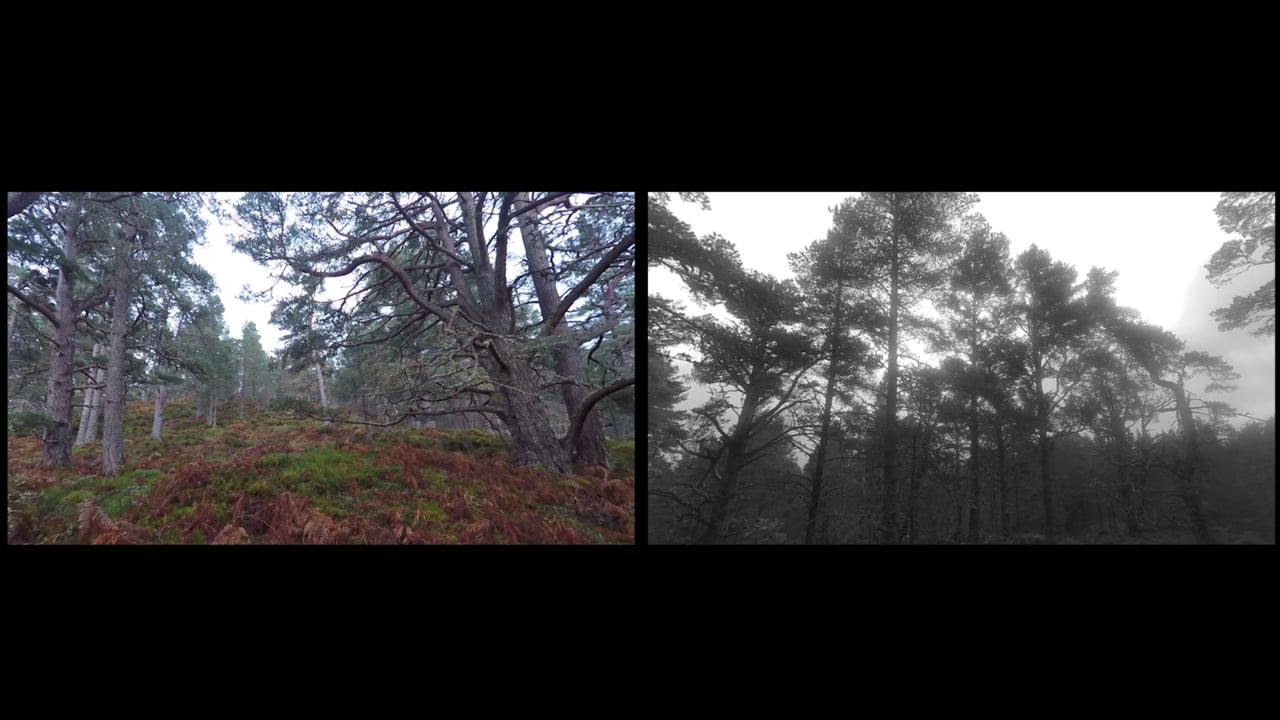Decoy is a film about being entangled with a forest and its wild things. The images were simultaneously shot deep in a Caledonian pine forest. The full coloured image moves forward into the landscape and the black and white image draws backward through the landscape. With this work we are trying to get at the passage of time in the forest and raise a set of questions about point of view, voice, representation and correspondent experience with a highland forest. We committed a period of months to this experiment, returning to the forests over and over again spending time during the deer rut, shooting late at night and early in the morning trying to find the right mix of weather and light. We bought and built various devices to limit our hand in the filming to let the forest tells its own story.
Text from the video: DECOY
The Caledonian forests of Scotland are living things that maintain themselves against the mischief of the world by their own capacity for self perpetuation, regeneration and expansion; they are vibrant with life forces.
Forests are often understood as places of harvest. In historical terms they were landscapes (with or without trees) occupied by four-footed creatures hunted for sport and food. Woodland managers understand forest as trees planted for felling. Ecologists are interested in forests for biodiversity. They see natural communities of trees and bushes, mosses, lichens, ferns and fungi that reflect a range of ages and support creatures large and small.
A wild forest suggests nature removed from human interest and influence. We are in one of the remnant semi-natural wild forests of Scotland. It is only one of six estates that are over 1000 hectares. A wild forest is presumed by many to be uninhabited and uncultivated, the longer it is ignored the wilder it becomes. We stand with many others that would suggest that a wild natural forest is a space that needs to be appreciated rather than ignored. A space where the aesthetic ecological and spiritual are closely aligned these forests have essential cultural import.
Decoys are primarily understood as skilfully crafted objects created to capture wild game. Decoys have been used to set traps and divert attention. As representations of living things, or as imitations or counterfeits of objects of desire they have been used to lure and entice others into compromising relationships.
Cultural decoys capture our attention and curiosity. They are autonomous objects that offer a visual and conceptual entanglement in things and meaning. They can most often be found in museums and archives. A cultural decoy is an embodied idea that has a finite form here and now but links to an infinite set of things that occupy a separate historical or spatial context. In this work they refer to the natural and cultural aspect of forests. If fully embraced our cultural decoys challenge ideas about the separation between artefacts, nature, cities and highland forests.
Art expresses human experience. it tests the boundaries of perception, meaning and value. Looking at art we begin with reflective awareness then slowly engage our memory and imaginative intelligence. How far from the world does art have to be to retain its strengths and how close to the world does it have to get to engage the interests of people, places and things? Art is one of the ways we understand who we are in this world. The decoy is used here as a creative vehicle to explore the relationship between nature and culture, cities and distant Caledonian forests.
Empathy is a type of perception led by something outside of us. It is about (but it is also more than) a simple understanding and inter-relationship with human and non- human others. Empathy is beyond self-interest and most often directed at something different or foreign. It involves attention to expressions of life force and engagement with the world. We use a metaphorical projection to comprehend the experience of the other. Empathy relies on the accumulation of familiar experiences and memories to give meaning to encounters with foreign things such as rare ancient forests.
As we consider Caledonian forests we ask ourselves what do they mean? These forests emerge from history, yet they are at the edge of imagination and often beyond the experience of many people that live in cities. Some of these forests are three hundred year old or more. They embody culture, reflecting centuries of conflict and land use changes. Yet they are living examples of something that is wild and free, uniquely Scottish. Some suggest that wild forests are best served when the rest of us choose to ignore them. Still others argue that wildness is an alignment of aesthetics, ecology and spirituality that demands to be engaged. Cultural Decoys provide creative visual and conceptual entanglement that can be more accessible than the forests themselves, yet build a community of interest around the idea and experience of these forests.
